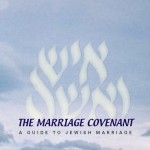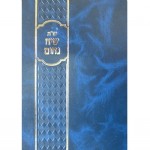Books of Interest: Recent Works in Halakha
November 17, 2009 by Shlomo Brody
Filed under Books of Interest, Halakha
Rabbi Elyashiv Knohl, The Marriage Covenant: A Guide to Jewish Marriage and A Guide to Marital Relations From a Torah Perpsective, Ein Tzurim: Yeshivat Kibbutz Ha-Dati, 2008. 297 pages + 57 pages pamphlet. [Translation of 2002 Hebrew edition.]
Rabbi Nachum Eliezer Rabinovitch, Shu”t Siach Nachum, Maaleh Adumim: Machon Ma’aliyot, 2008. 405 pages + index. [Hebrew]
Jeffrey I. Roth, Inheriting the Crown in Jewish Law: The Struggle for Rabbinic Compensation, Tenure, and Inheritance Rights, University of South Carolina Press, 2006. 154 pages + index and bibliography.
Rabbi Shlomo Goren, Responsa Releasing the Agunot of ‘Dakar’ Submarine, annotated by David Brukner, Reuben Mass Publishers, 2008. 112 pages. [Hebrew]
Rabbi Menachem Kasdan, Yesodei Ha-Tzedakah, 5769. 595 pages + indices. [Hebrew]
Rabbi Yehuda Henkin, Understanding Tzniut: Modern Controversies in the Jewish Community, Urim Publications, 2008. 141 pages.
Rabbi Danny Wolf, Minhah Tehora and Minhah Le-Aharon, Yeshivat Har Etzion. [Hebrew]
Kuntress Ha-Teshuvot He-Hadash: A Bibliographic Thesaurus of Responsa Literature published from ca. 1470-2000, ed. Shmuel Glick, Vol. 3 (Resh – Tav), Bar Ilan University and Schechter Institute of Jewish Studies, 2009.
Rabbi Elyashiv Knohl’s The Marriage Covenant represents a milestone in books on Hilchot Niddah and the Jewish view of marriage. The first 60 page section, “Beloved Friends,” includes both religious perspectives on marriage and sounds practical advice toward building a successful relationship. Section two, which represents the bulk of the book, is a thorough yet accessible presentation of Hilchot Niddah. The text, lightly but sufficiently footnoted for further reference, is both clear and accurate, giving the range of acceptable halakhic practice that is normally observed within our communities. Rav Knohl is not afraid of presenting more mekil positions to be used in times of need, but does so in a cautious and responsible manner. (The halakhic sections were reviewed by Rav Yaakov Ariel and Rav Zalman Nehemiah Goldberg, amongst others). Since this book is also partly written as a guidebook for newly-engaged couples, it includes a 3rd section that explains the laws and customs of weddings and sheva brachot.
The separate pamphlet includes a frank discussion about sexuality, discussing not only the various halakhot relating to sexual relations, but also hashkafic, psychological, and physiological perspectives on marital intimacy as a whole. Written in consultation with experts like Dr Anna C. Woloski-Wruble, Rav Menachem Borstein, and Dr. David Ribner, it remains both explicit and tasteful, and will surely be appreciated by newlywed couples.
The book includes the haskamot of Rabbis Yaakov Ariel, Zalman Nechemia Goldberg, and Aharon Lichtenstein.
This is a phenomenal contribution, and should become the standard reference book for all engaged couples.
Rabbi Rabinovitch, well-known as Rosh Yeshivat Birkat Moshe in Ma’aleh Adumim and author of a commentary to the Rambam’s Mishne Torah, has now published what appears to be the first of a series of volumes of responsa. The 117 responsa, of various lengths, reflect Rav Rabinovitch’s great erudition, as well as deep sensitivity to modern life. The topics cover a full range of topics, and include important statements regarding the use electricity on Shabbat, organ donation (in favor), and women’s issues. This work will certainly be appreciated by the community of Talmudic scholars and modern Orthodox society as a whole. Interested readers will also enjoy Rav Rabinovitch’s important work on contemporary hashkafa, Darkah Shel Torah.
As the subtitle indicates, Jeffrey Roth’s work details the historical development of rabbinic compensation, tenure, and succession as reflected in halakhic sources. Prof. Roth, a law professor at Touro College’s law school in Huntington, NY, successfully collects the major texts on these topics. The writing in this short monograph is lucid and clear, and I found it to be an insightful, resourceful work. For a brief discussion of some of the relevant sources discussed in this book, see my Ask the Rabbi column on rabbinic compensation.
In 1968, the Israeli Navy submarine “Dakar,” sailing from England to Israel, vanished at sea, with its wreckage only to be found in 1999. Rabbi Shlomo Goren was asked to rule on the halakhic status of missing soldiers and their wives, who remained potential agunot. His lengthy responsum on the topic, published in Meshiv Davar volume 3, has been slightly abridged and annotated by David Brukner, making this seminal teshuva accessible to a wider audience. Brukner’s historical and halakhic introduction is particularly helpful. This volume is a part of a larger series called ReShu”t that seeks to publish and explicate classic responsa related to modern questions. Additional volumes include Rav Moshe Feinstein’s responsum on Chalav Aku’m and Rav Yitzchak Herzog’s writings on the treatment of minorities in the State of Israel.
Rabbi Menachem Kasdan’s Yesodei Tzedakah is a combination of parshanut, lomdanut, philosophy, and halakhic analysis related to the mitzvah of tzedakah. Rabbi Kasdan explores a range of questions trying to understand the nature of the mitzvah, discussing both the obligation to raise the person’s spirits and also to give him physical support. Scholars will particularly appreciate the excursuses at the end of the book, including topics such as, “A Poor Person’s Obligation to Work as a Condition for Receiving Charity” (#1); “Should A Person Give Tzedakah Out of A Sense of Compassion or Entirely From Devotion to God’s Commandment?” (#4); and Takanat Usha”(#16).
Rabbi Yehuda Henkin’s Understanding Tzniut is contains a series of insightful essays regarding the laws of tznuit and their application in contemporary times. A selection of these essays were originally published in Tradition, including the article, “Contemporary Tzniut” (37:3), which includes serious criticisms of some of the rulings found in contemporary halakha handbooks on tzniut. While not everyone will agree with his positions, they are cogently argued, and represent an important contribution to the literature on this significant topic. Recommended for both scholarly and lay readers alike.
Rabbi Danny Wolf, longtime Ram in Yeshivat Har Etzion, has done the world of talmidei chachamim a great service in producing two works of both depth and clarity. Minhah Tehora introduces readers into the world of Taharot, giving iyyun analysis into central concepts such as avot ha-tumah, tumat ohel, etc… He also provides two interesting le-ma’aseh essays, one relating to the controversy of airplanes flying over cemeteries, and the other discussing Kohanim visiting concentration camps and mass graves in Poland (with detailed psakim regarding central sites). This book makes accessible the world of tahorot in a way not previously available. The 2nd book, Minhah Le-Aharon (dedicated to the memory of his father) focuses on central topics in Nashim. While this area of study is more accessible from other works, the essays remain elucidating and clear, and will certainly be enjoyed by those looking to study central sugyot in this realm.
Prof. Shmuel Glick has published the third volume of his important series. As I wrote last year regarding the first two volumes, “This new set is an incredibly valuable resource that thoroughly documents extant responsa literature published from 1470 to modern times. Each entry includes the responsa’s name, author, list of editions, sources of information about the book, and perhaps most importantly, bibliographical comments describing the content of the book. As such, the reader gets a good sense of the topics covered within the responsa. The entries also frequently provide a bibliography of relevant articles on the authors or topics covered within the collection. The entries also include material from the original Kuntress Ha-Teshuvot, written by Boaz Cohen in 1930.”
- Shlomo Brody
 Print This Post
Print This Post



